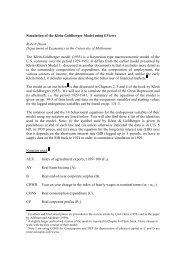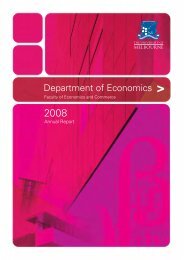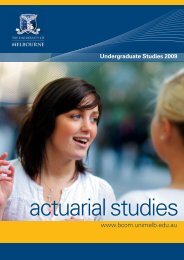Modified KPSS Tests for Near Integration - Department of ...
Modified KPSS Tests for Near Integration - Department of ...
Modified KPSS Tests for Near Integration - Department of ...
You also want an ePaper? Increase the reach of your titles
YUMPU automatically turns print PDFs into web optimized ePapers that Google loves.
<strong>for</strong> c > 0. In this way, one test dominates another if the <strong>for</strong>mer’s rejection pro…le <strong>for</strong> c > 0 (size)<br />
lies consistently below that <strong>of</strong> the latter. 2<br />
Figure 1 shows the rejection pro…les <strong>of</strong> the tests across c <strong>for</strong> a rejection rate <strong>of</strong> 0.50 when<br />
c = 0. When = 1, Q (10) is the optimal test so it dominates the other two tests everywhere.<br />
Between Q (10; 3:8) and S (10), it is Q (10; 3:8) which dominates, though not substantially. In<br />
fact, there is only ever a very modest amount <strong>of</strong> di¤erence between the size <strong>of</strong> all the three tests,<br />
with all having size close to zero when c = 10. The size <strong>of</strong> each test is also monotonic decreasing<br />
in c. For > 1, the rejection pro…les are no longer monotonic in c. There is always a region <strong>of</strong><br />
c <strong>for</strong> which the size <strong>of</strong> each test is greater than power. However, this e¤ect di¤ers signi…cantly<br />
across tests. As increases the size <strong>of</strong> Q (10) rapidly approaches 1.00 <strong>for</strong> most c, demonstrating<br />
its sensitivity to departures <strong>of</strong> the initial value from its optimality point. The other two tests sizes<br />
appear much less sensitive to increasing . Between these two, while there is virtually nothing<br />
to choose <strong>for</strong> = 2, <strong>for</strong> all 3 it is S (10) that clearly dominates Q (10; 3:8) in terms <strong>of</strong><br />
exhibiting the least size distortion .<br />
To compare …nite sample size, we consider the DGP (2) with = 0 and t generated by the<br />
MA(1) model<br />
t = t t 1<br />
with t i.i.d.N(0; 1). For Q (10) and Q (10; 3:8), we follow Müller (2005) and estimate ! 2 using<br />
residuals from an AR(1) regression <strong>of</strong> demeaned yt in place <strong>of</strong> the rc;t in (3). For all tests we use<br />
the QS kernel <strong>for</strong> (:) and employ the automatic bandwidth selection <strong>of</strong> Newey and West (1994).<br />
For T = 200 and c = 10, Table 1 shows the empirical size <strong>of</strong> the tests using nominal 0.05 level<br />
asymptotic null critical values, <strong>for</strong> various values <strong>of</strong> and . 3 Here S (10) controls size quite well<br />
across (note that its size here is invariant to ). In comparison, both Q (10) and Q (10; 3:8)<br />
are oversized <strong>for</strong> = 0:0; 0:6 and undersized <strong>for</strong> = 0:6. The oversizing problems also increase<br />
with the magnitude <strong>of</strong> - and at a drastic rate in the case <strong>of</strong> Q (10), in keeping with what our<br />
asymptotic results would predict.<br />
Overall, our …ndings indicate that despite its optimality, Q (10) is too susceptible to severe<br />
oversizing problems when > 1 to be recommended <strong>for</strong> practical use. While Q (10; 3:8) su¤ers<br />
rather less in this same situation, it is still the case that S (10) generally displays the more<br />
robust size control asymptotically <strong>for</strong> a given level <strong>of</strong> power and also has better …nite sample size<br />
properties. We there<strong>for</strong>e conclude that, in circumstances when there is some uncertainty about<br />
the generation <strong>of</strong> the initial value, the modi…ed <strong>KPSS</strong> test is likely to provide the most dependable<br />
inference <strong>of</strong> those considered here.<br />
Table 1: Empirical sizes at the nominal 0.05 level.<br />
0.0 0.6 0:6<br />
1 3 5 1 3 5 1 3 5<br />
S (10) 0.046 0.046 0.046 0.021 0.021 0.021 0.051 0.051 0.051<br />
Q (10) 0.060 0.592 0.999 0.000 0.000 0.016 0.096 0.711 0.999<br />
Q (10; 3:8) 0.060 0.091 0.130 0.000 0.000 0.000 0.088 0.116 0.149<br />
2 Note that when c = 0 all the tests are invariant to , so that the same critical values apply <strong>for</strong> all .<br />
3 For S (10) this is the standard <strong>KPSS</strong> value <strong>of</strong> 0.460. Unlike S (10), neither Q (10) or Q (10; 3:8) are invariant<br />
to when c = 10. For these two tests we use asymptotic critical values calculated assuming = 1. This is<br />
appropriate <strong>for</strong> Q (10) as = 1 is the value at which it is optimal. Also, it is not unreasonable <strong>for</strong> Q (10; 3:8)<br />
since this test is designed to have critical values that are fairly insensitive to .<br />
4







